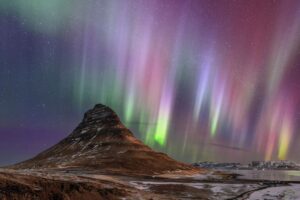Physical Address
23,24,25 & 26, 2nd Floor, Software Technology Park India, Opp: Garware Stadium,MIDC, Chikalthana, Aurangabad, Maharashtra – 431001 India
Physical Address
23,24,25 & 26, 2nd Floor, Software Technology Park India, Opp: Garware Stadium,MIDC, Chikalthana, Aurangabad, Maharashtra – 431001 India

The night sky over Iceland’s iconic Kirkjufell volcano is illuminated by the aurora borealis. These stunning lights occur when charged particles from the sun collide with gases in Earth’s atmosphere, with the colors indicating the specific atmospheric layer where these interactions take place. Image by BABAK TAFRESHI
By Rashmitha Diwyanjalee
What are the Northern Lights?
The Northern Lights, or aurora borealis, are a breathtaking natural light display commonly seen in the night sky of the northern hemisphere. They occur when charged particles from the sun collide with gases in Earth’s upper atmosphere, producing vibrant colors like green, pink, red, blue, and purple. These lights, known as polar lights or aurora polaris, also appear in the southern hemisphere as the southern lights or aurora australis.
The Northern Lights, or aurora borealis, can sometimes appear in unexpected places due to a combination of solar activity and Earth’s magnetic field dynamics. The related article can be reached here.
How Do Auroras Form?
Earth’s magnetic field lines. Image credit: NASA’s Goddard Space Flight Center.
Auroras are the result of interactions between the solar wind—a stream of charged particles from the sun and Earth’s magnetic field. This field acts as a shield, deflecting most solar particles. However, near the poles, where the field lines converge, some particles penetrate the atmosphere, leading to collisions with oxygen and nitrogen molecules. These collisions excite the gas molecules, causing them to emit light as they return to their ground state.
(The original video can be watched in Canadian Space Agency`s web from here )
The Chemistry behind the Aurora Borealis, or Northern Lights
Earth’s magnetosphere shields us from most solar particles, but some manage to penetrate through a ‘cusp’ in this shield, creating the daytime aurora. Most solar particles enter the magnetosphere on the night side and travel along magnetic field lines towards the polar regions (T. Abrahamsen/ARS)
The stunning displays of the aurora borealis, or Northern Lights, are a result of complex interactions between charged particles from the sun and gases in Earth’s atmosphere.
Solar Wind and Charged Particles: The sun constantly emits a stream of charged particles known as the solar wind. These particles are primarily electrons and protons. During periods of intense solar activity, such as solar flares and Solar Flares and Coronal Mass Ejections (CMEs), the number of charged particles released increases significantly.
Collision with Atmospheric Gases: When these high-energy charged particles collide with gases in Earth’s upper atmosphere (the thermosphere and exosphere); they transfer energy to the gas molecules. This energy transfer excites the electrons in the gas molecules, causing them to jump to higher energy states.
Emission of Light: As the excited electrons return to their original energy levels, they release the absorbed energy in the form of light. This process is called photon emission.
Solar particles collide with atmospheric atoms, causing their electrons to move to higher orbits. When these electrons return to their original orbits, they release energy as light (T. Abrahamsen/ARS).
Altitude Variations: At higher Altitudes (above 150 km), oxygen atoms are more prevalent and typically produce red and green colors. At Lower Altitudes (below 150 km), nitrogen molecules dominate and produce blue and purplish-red colors. Read more on Canadian Space Agency.
Therefore, the auroras’ colors depend on the type of gas and the altitude at which the collisions occur:
The ionosphere, a layer of charged particles in Earth’s atmosphere, extends from about 50 to 360 miles above the surface. Processes within this layer also create bright swaths of color in the sky, known as airglow. Image by : NASA
Impact of Climate Change on the Northern Lights
While the Northern Lights are primarily driven by solar activity and Earth’s magnetic field, climate change can influence this natural phenomenon in several indirect ways:
The Complexity of the Relationship
The link between climate change and the Northern Lights is complex and not fully understood. The primary drivers—solar activity and Earth’s magnetic field—are influenced by factors beyond climate change. However, climate change can indirectly affect the Northern Lights by altering atmospheric and geomagnetic conditions. Ongoing research aims to unravel these interactions and predict how future climate changes might impact this mesmerizing phenomenon.
On December 25 and 26, 2022, researchers documented a rare polar rain aurora from Longyearbyen, Norway, visible beneath the more common aurora borealis. Polar rain auroras form through a different mechanism than typical auroras and are extremely difficult to observe. Image by: FREDRIK MELING
Therefore, the Northern Lights are a natural testament to the dynamic interactions between the sun and Earth. Climate change has the potential to influence their visibility and intensity through indirect effects on the magnetic field and atmospheric conditions. As we continue to study these relationships, we gain a deeper understanding of how our changing planet impacts the natural wonders that have fascinated humanity for centuries.